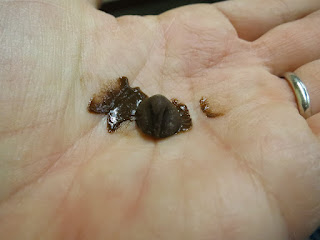Today's focus-- The Science of Melting
Supplies:
ice (cubes plus one larger "iceberg" frozen before class in a plastic bag or jug)
water
chocolate chips
birthday candles
wet sand
matches or lighter
salt
sugar
powdered paint OR Kool-aid
What we read:
What we did:
As a group today, we talked about melting and what makes things melt. We tried melting both chocolate chips and candles in our hands:
(sorry, that's kind of a gross picture, and no, there's no candle in that hand.) Then we applied a little more heat to the candles to see if they would melt:
Then, we made notes about our findings.
Then, just for fun, I brought out a big ice cube (water frozen in a plastic milk jug, then cut out of the jug) and I asked the kids if they thought that heavy thing would float or sink (yes, it was mixing up my lesson goal for the day by throwing in a question about floating and sinking, but I just couldn't resist!) and everyone was surprised to see it bob to the top of the water. This is what it looked like after melting through two class periods.
Then the kids got to experiment on their own with ice, water, sugar cubes and salt to see how those things interacted with melting:
We also tried powdered drink mix (I didn't have the powdered tempera paint that was recommended) to try to "paint" with ice.
Teaching Resource:









No comments:
Post a Comment